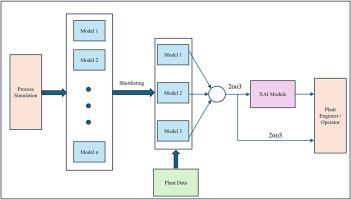Advancing fault diagnosis for ethyl benzene production plant: A machine learning and explainable AI approach
IF 3.4
4区 化学
Q2 CHEMISTRY, MULTIDISCIPLINARY
引用次数: 0
Abstract
Fault diagnosis in chemical process plants is critical to ensuring operational safety, product quality, and economic performance. In complex units such as ethyl benzene production plant, early fault detection is challenging due to nonlinear process dynamics, strong variable interactions, and the scarcity of labelled fault data. To address this gap, this study presents a simulation-driven, explainable machine learning-based fault diagnosis system (FDS) capable of identifying multiple fault types without reliance on extensive historical plant data. A dynamic process simulation was conducted to generate datasets under both normal and faulty operating conditions. The system was first operated for 20 h in normal closed-loop mode with a 0.6-min sampling interval to form the baseline dataset. For each fault case, the simulation was reset and run for 5 h to allow stabilization, followed by 15 h of faulty operation, producing 2001 samples across 28 process variables per case. Fourteen representative faults, including sensor bias, actuator malfunctions, and process disturbances, were introduced. After feature selection, multiple classifiers were trained, and three high-performing yet diverse models, Ensemble Bagged Trees (tree-based), Support Vector Machine (kernel-based), and Fine KNN (distance-based), were integrated using a majority-voting mechanism to enhance robustness. EBT being best performing model achieved 99.98 % accuracy and an F1 score of 0.9988. Local Interpretable Model-agnostic Explanations (LIME) provided transparent insight into variable importance for each fault class, aiding interpretability. The novelty of this work lies in generating realistic labelled datasets entirely from dynamic simulation, combining heterogeneous algorithms for improved generalization, and embedding explainable AI (XAI) to create a scalable, transparent FDS framework applicable to other chemical processes with limited fault history.

推进乙苯生产装置故障诊断:一种机器学习和可解释的人工智能方法
化工设备的故障诊断是保证生产安全、产品质量和经济效益的关键。在乙苯生产装置等复杂装置中,由于非线性过程动力学、强变量相互作用和标记故障数据的稀缺,早期故障检测具有挑战性。为了解决这一差距,本研究提出了一种仿真驱动的,可解释的基于机器学习的故障诊断系统(FDS),能够识别多种故障类型,而不依赖于大量的历史工厂数据。对正常工况和故障工况下的数据集进行了动态过程仿真。系统首先在正常闭环模式下运行20小时,采样间隔0.6 min,形成基线数据集。对于每个故障情况,模拟被重置并运行5小时以允许稳定,然后是15小时的故障操作,每个情况下在28个过程变量中产生2001个样本。介绍了14种典型故障,包括传感器偏置、执行机构故障和过程干扰。在特征选择之后,训练多个分类器,并使用多数投票机制集成三种高性能但多样化的模型,即Ensemble Bagged Trees(基于树的)、Support Vector Machine(基于核的)和Fine KNN(基于距离的),以增强鲁棒性。EBT是表现最好的模型,准确率为99.98%,F1分数为0.9988。局部可解释模型不可知论解释(LIME)提供了对每个故障类别的变量重要性的透明洞察,有助于可解释性。这项工作的新颖之处在于完全从动态模拟中生成现实的标记数据集,结合异构算法来改进泛化,并嵌入可解释的人工智能(XAI)来创建一个可扩展的、透明的FDS框架,适用于其他具有有限故障历史的化学过程。
本文章由计算机程序翻译,如有差异,请以英文原文为准。
求助全文
约1分钟内获得全文
求助全文
来源期刊
CiteScore
3.50
自引率
7.70%
发文量
492
审稿时长
3-8 weeks
期刊介绍:
The Journal of the Indian Chemical Society publishes original, fundamental, theorical, experimental research work of highest quality in all areas of chemistry, biochemistry, medicinal chemistry, electrochemistry, agrochemistry, chemical engineering and technology, food chemistry, environmental chemistry, etc.

 求助内容:
求助内容: 应助结果提醒方式:
应助结果提醒方式:


